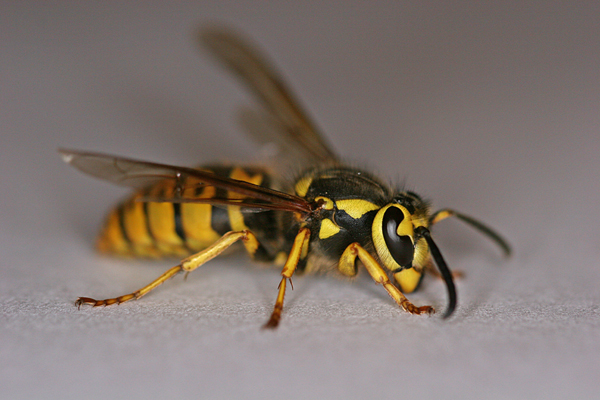SERVICE REQUEST?
Fill out the form below.
Find our nearest location
Your Local Office

Yellow Jacket
Attribution: Bombman356, [CC-BY-SA-3.0], via Wikimedia Commons
Size:
About 1/2 -to 1-inch in length.
Color:
Generally small wasps with black and yellow stripes.
Behavior:
Yellow jackets are social insects that live in colonies containing thousands of individuals. Colonies are usually started by a single queen in the early spring, and are very small for the first couple of months. By midsummer, a colony located on or near a house is usually large enough to become a nuisance. These wasps will aggressively attack when their nest is disturbed, and can inflict painful stings. Unlike the honeybee, which stings only one time and then dies, a single yellow jacket can sting many times. Yellow jackets are scavengers and can be beneficial when located in a wooded area or a field. Colonies located in or near a home, however, can pose a threat to the persons living in the house. When this situation is discovered, the colony or colonies should be eliminated. Because of the danger involved in treating these nests, only a professional such as Terminix should attempt to treat them. Should a colony be discovered, contact your local Terminix service professional for assistance.
Yellow jackets prefer to locate their nests in the ground, usually in an old rodent burrow or similar hole. This wasp also commonly locates its nest inside the walls of a building by entering through cracks or holes in the outside walls.
The following precautions should be taken to prevent accidental stings:
- When working in a garden or flowerbed, be aware of numerous wasps flying into and away from a single point in the garden or to a hole in the side of the house. This will usually indicate where a colony might be located.
- Be careful when using powered lawn equipment, such as edgers, trimmers and mowers. Loud, vibrating noises disturb yellow jackets and may send them into an attacking frenzy.
- Stay away from yellow jacket nests once you know where they are located.
- Sometimes they might actually eat through an interior wall and enter the house.
Family Name:
Vespula spp.
Read What Our Clients
Are Saying
My Terminix tech Scott is the best! He is professional, courteous and absolutely thorough about his job. Thank you for sending such a blessed tech to my house. Hamlet, NC
This letter is to say how pleased we are here at Morreene West Apartments with your services. We are very pleased with the technician, Christopher. He does a great job. Durham, NC
Terminix has consistently offered our apartment complex reliable, competent service. We are completely satisfied with their knowledgeable representative who is always punctual and does a superior job for us every time. Chapel Hill, NC
I would like to take the time to thank you for giving us such great service here at Carver Pond Apartments. Your Pest Technician Christopher Mitchell has provided us with excellent service over the last few months. Christopher is such a great help to us in providing helpful information so that we can better serve our residents here at Carver Pond. Durham, NC
SERVICE REQUEST?
Fill out the form below.